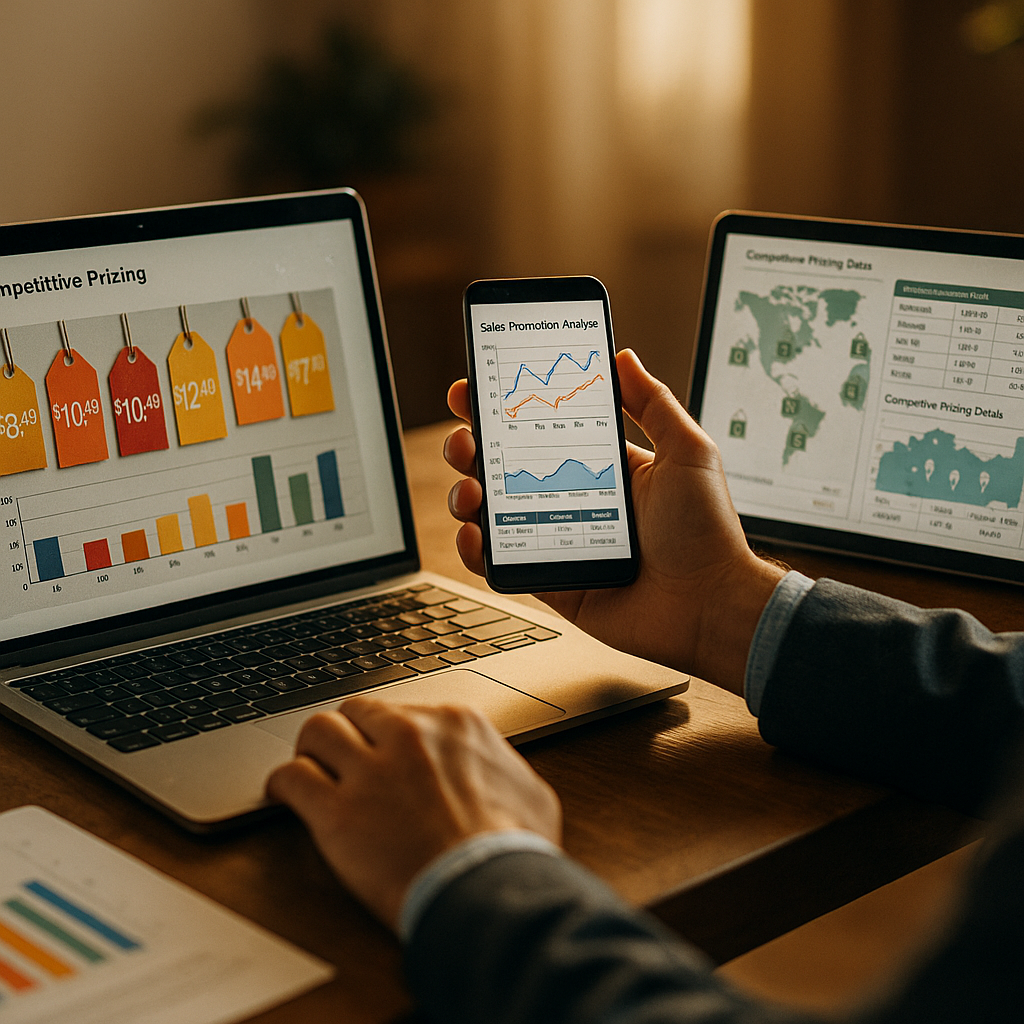Competitive intelligence tools for pricing and promotions have become essential for businesses seeking to maintain a profitable edge in 2025. They allow companies to track competitors and adjust pricing strategies in almost real-time. In this article, we explore advanced solutions that empower data-driven decisions and discuss how to implement them for maximum ROI. Ready to revolutionize your approach?
Understanding Competitive Pricing Analysis
Competitive pricing analysis is the backbone of an effective market strategy in today’s fast-moving commercial landscape. It involves systematically monitoring and assessing competitor prices, promotional activities, and market trends. By leveraging high-quality data, businesses can optimize their pricing to attract customers while safeguarding margins.
Recent studies show that companies using automated pricing tools experienced up to a 17% revenue increase in 2024, highlighting the value of real-time insights. A robust competitive pricing analysis engine employs machine learning to spot patterns, trigger alerts on price changes, and forecast future shifts. This empowers decision-makers to respond proactively, rather than reactively, to market fluctuations.
Features to Seek in Pricing Intelligence Software
Pricing intelligence software should equip organizations with more than just data collection. Look for platforms that offer:
- Real-time monitoring: The ability to track market shifts as they happen enables agile pricing adjustments.
- Automated price scraping: Collecting pricing and promotional data from multiple competitors and channels.
- Advanced analytics: Machine learning and AI-driven insights to suggest optimal pricing points and promotional tactics.
- Dynamic repricing: Rules-based engines to automatically update your pricing on e-commerce platforms.
- Intuitive dashboards: Visualization tools that make complex datasets easy to interpret and share across teams.
The leading providers now also integrate with ERP, CRM, and e-commerce systems, ensuring seamless data flow and actionable intelligence where it’s needed most.
Promotional Intelligence Tools for Dynamic Campaigns
Promotional intelligence tools analyze how discounts, coupons, and special offers impact both competitive positioning and ROI. These tools track not only what your rivals are offering but also measure the effectiveness of your own campaigns in real time.
The most advanced solutions in 2025 utilize AI to:
- Segment your market and personalize promotions.
- Monitor the duration, depth, and frequency of competitors’ offers.
- Run A/B tests and attribution analysis to assess campaign efficacy.
- Alert you to strategic opportunities or threats.
Promotional intelligence empowers you to avoid races to the bottom on price, focusing instead on high-value offers tailored to well-defined customer segments. Integrated feedback loops link promotion performance to inventory and supply chain data for maximum efficiency.
The Business Impact of Price Monitoring Tools
Price monitoring tools deliver far-reaching benefits for modern enterprises. By providing actionable insights, these tools help optimize profit margins, enhance customer trust, and avoid pricing conflicts with key partners. Retailers using such solutions have reported inventory turnover improvements and higher customer retention rates, as they match prices to real-time demand dynamics.
For global brands, price monitoring tools are especially critical in ensuring compliance with market-specific regulations and guarding against unauthorized sellers or gray market activity. Robust audit trails and reporting features also foster transparency—an increasing requirement among shareholders and regulators alike.
How to Implement Competitive Intelligence for Pricing and Promotions
Implementing competitive intelligence for pricing and promotions requires a strategic approach. Begin with a clear mapping of your competitive landscape—identify key rivals, channels, and segments. Next, select intelligence tools that integrate with your existing tech stack and fit your business objectives.
- Define objectives: Are you targeting margin improvement, volume growth, or market share?
- Pilot test: Start with one category or region to refine processes before scaling up.
- Train your teams: Ensure both commercial and technical staff understand the new workflows and decision points.
- Review & optimize: Analyze performance, collect feedback, and fine-tune your automation rules.
Importantly, set up robust security and compliance processes—data privacy and ethical concerns around scraping and data usage are top priorities for credible market players in 2025.
Integrating Competitive Intelligence with Other Business Functions
Integrating competitive intelligence tools with broader business operations enhances outcomes. Syncing competitive insights with your supply chain, inventory, and marketing automations ensures consistency of message, availability, and pricing. For example, price elasticity data from intelligence platforms can inform procurement decisions or inventory re-allocation.
More organizations now use APIs to connect pricing intelligence with ERP, logistics, and customer support platforms. This holistic view supports precise demand forecasting and strengthens cross-functional collaboration—clear competitive advantages in unpredictable markets.
In conclusion, competitive intelligence tools for pricing and promotions give businesses the data and agility to outperform their rivals in 2025. Choosing the right mix of features and integrating them across business functions provides a sustainable edge. Future-proof your strategy now by prioritizing real-time, actionable intelligence.
FAQs about Competitive Intelligence Tools for Pricing and Promotions
-
What are competitive intelligence tools?
These are software solutions designed to gather, analyze, and report real-time data on competitors’ prices and promotions, enabling companies to make agile, informed business decisions.
-
How do pricing intelligence tools improve profit margins?
They track competitor pricing and adjust your prices dynamically to maximize sales and margins while remaining competitive, reducing lost revenue from underpricing or overpricing.
-
Are pricing and promotional intelligence tools suitable for small businesses?
Yes. Many tools offer scalable, affordable packages with modular functionality—ideal for small and mid-sized enterprises needing actionable insights without large IT investments.
-
What risks should I be aware of when using automated pricing tools?
Key risks include compliance with data privacy laws, avoiding price wars, and ensuring data accuracy. Partnering with reputable vendors and implementing clear internal controls helps mitigate these risks.
-
Can these tools integrate with my current business systems?
Most modern solutions offer robust APIs for seamless integration with ERP, CRM, and e-commerce systems, enabling fast, actionable intelligence across your entire operation.
